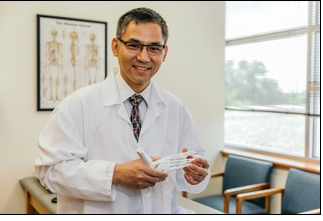Keeping Feet Healthy with Age: Strategies for Comfort and Mobility By Dr. Phinit Phisitkul
Keeping Feet Healthy with Age: Strategies for Comfort and Mobility By Dr. Phinit Phisitkul
Blog Article
Achilles tendonitis is an extremely common condition that is a problem with the Achilles tendon, which connects the muscles of the calf to the heel bone. For Dr. Phinit Phisitkul , identifying the reasons behind the condition, recognizing symptoms, and exploring effective treatments are crucial to managing and recovering from Achilles tendonitis.

Causes of Achilles Tendonitis
The repetitive strain that is imposed to the Achilles tendon, for example running, jumping or sudden changes in direction, could result in tendonitis. This is most common among athletes and individuals who suddenly increase the intensity or intensity of their activities.
Incorrectly fitting shoes or footwear that don't provide enough support or cushioning could contribute to the formation of Achilles tendonitis. Shoes that aren't fitted well or have inadequate shock absorption can put extra strain on the tendon.
Foot mechanics that aren't working properly, such as low arches or flat feet, can affect how the Achilles tendon functions which increases the chance of developing tendonitis. Poor alignment or movement patterns can be a contributing factor to the condition.
Symptoms of Achilles Tendonitis
Pain is typically felt along the heel's back or inside the tendon itself. It is usually caused by physical exercise or after a period of rest. The pain could start as a mild ache and gradually increase in intensity.
An Achilles tendon injury can result in swelling around the heel or tendon area. The swelling could be accompanied by heat or redness. Finally, stiffness in the tendon could limit the range of motion which can make walking and moving the feet difficult.
Best Treatment Approaches for Achilles Tendonitis
The first step is to rest the affected toe and applying an ice will aid in reducing pain and inflammation. Beware of activities that may aggravate symptoms is essential for healing. Ibuprofen, a prescription drug available over the counter, will help to manage the pain and decrease swelling.
Physical therapists can provide exercises to strengthen the muscles of the calf and increase flexibility in the Achilles tendon. The stretching and strengthening exercises aid in reducing symptoms and preventing future injuries.

Also, wearing supportive shoes that have cushioning orthotic inserts can reduce strain and promote healing. Lastly, in cases where conventional treatments fail to offer relief, medical procedures such as corticosteroid injections or surgery might be suggested.For more details please click on this link Dr. Phinit Phisitkul Dakota Dunes, SD. Report this page